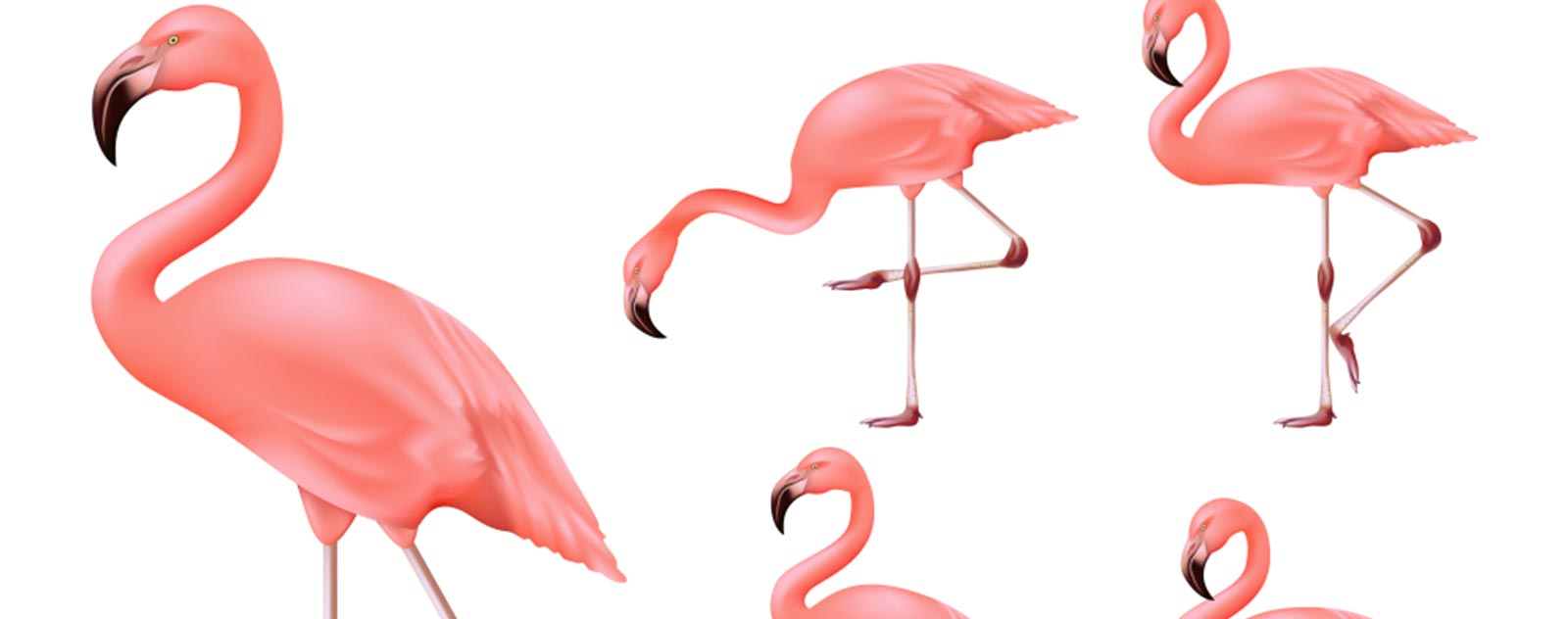Do you want to learn how to draw a flamingo easier? You are in the right place.
We have researched the right ways to make a beautiful bird drawing. We are interested in different methods of drawing birds. To give you a taste, here is a short answer:
Just like herons and storks, flamingos have distinctive traits not found in any other bird on the planet. To know how to draw a flamingo, you need a good attitude and the right materials.
In this article you will discover:
- Who are the flamingos;
- How to draw a flamingo;
- The various stages of drawing this majestic bird.
WHO ARE THE FLAMINGOS?

Flamingos are birds that live in communities, always grouped in more or less large flocks. These are the best known and most majestic birds. They have a particular morphology, that is to say feathers of beautiful colors , a beak and quite specific legs. These pink flamingos live in captivity particularly in bad conditions which can cause them to lose their natural color.
Thus, we can say that these birds are not able to produce their own dye. This dye would probably come from their diet. Flamingos feed on Artemia salina shrimp and pink-type algae (indirectly); these species live in the waters of lagoons and at the level of brackish ponds.
Using their specific beak equipped with a filter, the flamingos capture small crustaceans, which in turn consume pink unicellular algae. These algae have the capacity to manufacture and also contain photosynthetic pigments which will then be transmitted all along the food chain. The pigments in question are in particular carotenoids similar to those found in carrots and many plants.
MATERIALS TO DRAW COLORFUL ANIMAL

In the Nordic countries, there are very rarely brightly colored birds. The child is accustomed to the gray sparrow, the black crow. More red-breasted birds. If the child sees a diverse group of birds of unusual colors, he arouses great interest.
Flamingos are very interesting because they have a pink color. These thermophilic birds live in southern countries. If your child is interested in flamingos, you can draw it together, taking advantage of our teaching.
You need to :
- Sheet of paper ;
- Pencil ;
- Rubber ;
Procedure and explanations:
- Draw the beak
Indeed, for more ease, it is preferable to start with the beak. Knowing that this allows everyone to determine in advance the dimensions of their flamingo. To do this, start by drawing half a boomerang, then draw a separation between the upper and lower beak. This will easily leave a place for a small right-angled triangle, which will look like a nostril.

-
Draw the neck and the eye
Draw its eye directly at the end of the base of its beak, and from there draw two parallel S-shaped strokes for its neck.

-
Draw your body
To draw the body of your flamingo, all you need to do is draw a large wing. Which you can refine by adding many feathers.

-
Draw his paws
As for its legs, it is better for you to think at first of an oblique tree branch, representing a bent leg. And another vertical tree branch, to represent the leg on which the flamingo stands.

-
Add decor
To be more realistic, we suggest that you put grass under the legs of your flamingo. This saves you from having to perfect his claws.

-
Getting into coloring
Once your flamingo has been drawn, now is the time to color it pink, so it can proudly display its name. Leaving you the choice of the color of the grass.

- Before painting, you can examine the photos of the flamingo to see what it looks like. Its trunk has the shape of a small oval.
- Like all birds, the flamingo's head is small. Draw an oval a short distance from the first digit.
- The flamingo is very similar to a crane due to its long neck. With its help, the bird can quickly catch fish in the water.
- Now adjust the line of the neck of the flamingo, which is smoothly connected with the head of this bird. Delete the excess lines from the ovals.
- The tail of the flamingo is peculiar and is always curved downwards. Correct the torso, making it more realistic.
- Erase the baseline, to get the image without unnecessary details. Carefully inspect the drawing and correct the outline of the flamingo .
- The bird's beak is also unusual. Its beak bends at the end. This structure helps the flamingo not to lose the slippery fish. Draw the bird with long legs, one of which is bent. Make the contours more voluminous, draw the legs and their curvature.
- As the flamingo is turned on its side, only one eye can be seen. Draw the flamingo's eye next to the beak.
- On the trunk, draw the wing, and the flamingo beak at the bottom paint it black.
- Choose with your child the most beautiful shades of pink and red and paint the flamingo. Paint with your child also online. We have specially prepared the flamingo for you to color online.
HOW TO DRAW A PINK FLAMINGO?

Flamingos are familiar even to those who have never seen one in real life. These large birds have long, stick-like legs , bent knees, and long, curvy necks. To create this project you will need the following supplies:
- An HB graphite pencil
- A 3B graphite pencil
- Eraser
- Drawing on paper
How to draw a flamingo
- Step 1
I draw a rough shape of the flamingo's head, using the HB graphite pencil.
I add a shape of the bird's beak; it is solid and slightly curved downwards.
- 2nd step
I add the long line of the neck; it has an "S" shape . This position can vary and sometimes the line of the neck becomes much straighter or, on the contrary, has even more curves.
- Step 3
I draw a rough shape of the flamingo's body; it looks like a stylized droplet lying on its side.
- Step 4
I add a texture of the first leg, marking the ankle with an oval. For now, let's keep the scheme as simple as possible. It's hard to say why flamingos tend to stand on one foot.
But keeping one of their feet out of cold water is thought to help birds retain body heat. However, this behavior also occurs in warm waters and in birds that do not normally stand in water.
It also seems to be a comfortable resting position for flamingos; the one-legged pose can be maintained without any muscle activity. In fact, the neck and leg positions of flamingos can be quite varied. Don't feel limited to just one!
- Step 5
It's time to refine the head of the bird in our drawing. It is relatively small, compared to the massive black-tipped beak with a distinctive downward slant. The lower part of the beak is much larger and stronger than the upper part.
A flamingo's beak has a filter-like structure that helps remove food from the water before the liquid is expelled. You can find a stylized illustration of a flamingo's head in the image below. I add a small eye and then refine the outlines of the upper and lower banknotes.
- Step 6
I outline the contours of the bird's wing. A flamingo has a massive blanket of feathers; some of them, especially on the lower body, are longer, with sharp outlines.
The feathers on the upper part of the body give a softer and fluffier impression: often you cannot distinguish the individual feathers there. I divide the bird's body into parts (or layers) to make the process of drawing the feathers easier.
- Step 7
I draw the contours of the flamingo's neck, connecting the head and the body.
- Step 8
Slim the leg, depending on the structure. The three main toes are webbed to help distribute the bird's weight when on soft mud, and also to act as a paddle when the flamingo is swimming. I add the contours of the visible part of the bent leg.
- Step 9
I refine the outer outline of the wing, marking the feathers, then I create an illusion of soft feathers on the upper body. The direction of the pencil lines accentuates the contours of the flamingo's body.
I add the longest feathers. They can puff out more in slightly different directions or just meet at the end of the tail.
I decided to make this flamingo more artistic and stylized, so I drew a decorative tail, paying attention to the long feathers.
- Step 10
With the HB pencil, I apply graphite hatching to give more volume to the drawing. I accentuate the lower part of the bird's body and the areas between the long feathers.
There must be shadows on the bird's neck and legs. And, as a nice addition, a drop shadow makes the bird's figure more stable.
- Step 11
With the 3B pencil, I increase the contrast in my drawing. Flamingos have black feathers under their wings, so I'm creating a clue for them. I also darken the tip of the beak and the area around the eye to make the artwork more expressive.
It's a good trick to use a sharp eraser tip to add small highlights on the feathers and create a smooth transition between short and long feather areas. As a finishing touch, I add graphite dots to the shadow under the flamingo to create an illusion of grainy sand.
Other methods to make the flamingo drawing

Drawing the flamingo is not complicated: its graceful silhouette requires clear lines and delicate colors. Being a large migratory bird , admired for its elegance and beauty, the flamingo (phoenicopterus roseus) lives in estuaries. And along the coasts of Asia, Africa and southern Europe. It can be easily spotted in France (Camargue), Spain, Portugal, Greece, Turkey, Albania, Cyprus, Pakistan and India.
In our country, the flamingo nests regularly in Emilia-Romagna, Puglia, Sardinia, Sicily and more rarely in Tuscany and Veneto. There are several curiosities about the greater flamingo, from the color of its plumage due to its diet to its posture on one leg to save energy. These pink birds live in very dense communities especially during nesting. Her delicate and curvy figure has always attracted attention.
Artists such as photographers, illustrators and painters who are fascinated by its silhouette, its movements and the pink of its feathers. If you want to learn how to draw this creature, you need to do some research and observe it carefully. Drawing a flamingo is not difficult, but it is important to identify the geometric figures that make up its body, characterized by long legs and a long neck .
- At first, you should sketch out the basic structures of the flamingo, in particular making a smaller oval for the head, a larger oval for the body, and the lines for the neck and legs.
- Then continue adding to the lines you have drawn other lines to make the limbs and neck thicker.
- Then go to the next step to better outline the beak, feathers, wings and legs and finally, color your flamingo.
If you love flamingos, we invite you to discover a collection of flamingo jewelry exclusively available in the Roseus store. Discover their sublime flamingo earrings for women.
HOW TO DRAW A PINK FLAMINGO WITH A STARTING GRID

You can print the basic construction lines and start drawing on tracing paper or you can draw the grid yourself by following these steps:
- Highlight the width and height of the image. Draw two ovals for the flamingo's head and body. Add a line that will be the center of the beak.
- With the light guide lines, draw the neck. Define the legs of the flamingo.
- Define, with a small circle, the place of an eye. Add lines for a wing and show the beak.
- Finish with the shape of the wing and the legs.
- Draw lines for the rows of flamingo feathers and fingers . Add details to the head.
- Draw additional lines to show the shape of the fingers, joints, webbed feet. Tail line.
- Work on the figure of the flamingo, paying particular attention to detail. Draw feathers.
- Contrast, trying to vary the thickness and intensity of the lines. Draw more details. Mark out the land. Erase all guidelines.
Another method for drawing the animal step by step

Flamingos are not similar to other ciconiiformes, they have characteristics to pay attention to. In order to draw a flamingo as if it were alive, that is, to reproduce the regular contours of its graceful curves as accurately as possible, it is good to again carefully look at the first photo presented in the article.
- Pay attention to the bird's long neck and try to transfer what you see onto a piece of paper as accurately as possible. Connect the upper oval to the smooth lower curved line and, parallel to it, draw exactly the same. If done correctly, then the neck of the flamingo is ready.
- The last step at this stage will be the image of the legs of the bird. They are long, the knees bent towards the unknown side. Draw their shape , calculating that the legs should take up as much space on the paper as the head, neck and torso.
- To draw the rest of the body , now draw the beak of the bird. A flamingo's beak is unusual. We will try to present it correctly. To draw a flamingo in pencil, as a professional artist, you need to carefully approach this part of the picture, because the pink beauty has a very special beak. It is a cross between a parrot's "nose" and a toucan's beak. The main distinguishing feature is the downward curvature.
- Next, draw an eye. Remember that flamingo eyes are small.
- Do the final review of the image. It begins with the legs of the flamingo.
This bird has membranes between its fingers, so we clearly drew three fingers and connected them at the top with arched lines, curving downwards. Much attention is paid to the knees of the bird.
We draw them as the intersection of two thin bones. The whole wing is decorated with small feathers, the ends of which are directed downwards. It is not necessary to depict a lot of feathers on the neck of the bird, because it is still impossible to draw them like a flamingo.
In nature, the pink beauty of this part of the body feathers is very dense and gives the impression of a completely flat surface. From the bird's eye to the beak, it is worth drawing lines to later leave this undecorated white-colored place.




